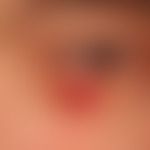Synonym(s)
HistoryThis section has been translated automatically.
DefinitionThis section has been translated automatically.
Indolent (low-malignant), CD30-positive, particularly benign lymphoproliferative disease with a recurrent course over many years, characterized by single or multiple, painless, papulo-nodular or ulcerative papules and nodules with spontaneous healing, but also months, possibly even years of latency.
Note: Some authors consider the clinical picture to be benign!
You might also be interested in
Occurrence/EpidemiologyThis section has been translated automatically.
Prevalence 0.1/100,000 inhabitants/year. Worldwide occurrence. Predominantly in members of Caucasian ethnic groups, the proportion of CTCL is about 18%. w:m=2.3:1 (according to other sources: 1:1).
EtiopathogenesisThis section has been translated automatically.
Unknown. Viral genesis? There is an increased association with atopic diseases in adolescent patients. The detectable mutation in SDC1, COL4A1 and laminin-5 genes may be associated with tumor recurrence or progression to higher-grade lymphoma (Wang TT et al. 2017).
Patients with iatrogenic immunosuppression or age-related immunosenescence may in rare cases develop EBV-induced lymphoproliferative disease (lymphoid infiltrates consisting of atypical CD30-positive T cells or B cells with variable EBER expression) with the clinical aspect of lymphomatoid papulosis (Hooper MJ et al. 2023) (see also under methotrexate-induced lymphoproliferative disease)
ManifestationThis section has been translated automatically.
Mainly adults; age: 7-83 years, average age: 39 years (Xiong J et al. 2015); in a larger study of 20 patients, the average age was 28.6 years (Wang TT et al. 2017). Very rarely, the disease is also found in children and adolescents.
LocalizationThis section has been translated automatically.
Trunk>Extremities>Face and eyelids. Rarely affected is the oral cavity.
ClinicThis section has been translated automatically.
Mostly multiple, more rarely only single (rarely more than 5, disseminated occurrence is possible, but the exception), red to red-brown or brown-purple, soft-elastic, painless, surface-smooth, flat, red papules forming within a few days (eruption phase). These develop (surprisingly quickly) into red, always painless nodules (up to 2 cm in diameter) with an initially smooth surface.
The initial hemorrhagic crust formation regularly leads to torpid disintegration of the central nodules. This results in morphological changes! Clinically, in this developmental phase, only an ulcer of varying depth (which cannot be explained to the examiner), usually hardly painful and similar to an eschar, makes an impression. Risk of secondary infection (picture of pyoderma). Healing with the formation of an unspectacular, hyper(hypo)pigmented scar.
Spontaneous regression after 3-8 weeks with the formation of scaly crusts and scarring.
HistologyThis section has been translated automatically.
Type A: Dense, diffuse, mixed-cell infiltrate extending into the subcutis, consisting of pleomorphic and anaplastic lymphoid cells as well as numerous eosinophilic and neutrophilic granulocytes, histiocytes and small lymphocytes. Numerous mitoses.
Type B: Ribbon-like dermal epidermotropic infiltrate of small to medium-sized lymphoid cells with chromatin-dense cerebriform nuclei.
Type C: Dense, diffuse infiltrate of large anaplastic cells extending into the subcutis. Few eosinophilic or neutrophilic granulocytes, histiocytes and small lymphocytes. Numerous mitoses (by far the most common type- Wang TT et al. 2017).
Type D: Dense, diffuse infiltrate of small to medium-sized CD8+ and CD30+ lymphocytes extending into the subcutis. Significant epidermotropy.
Type E (angioinvasive type): Dense, angiocentric and angioinvasive, mixed-cell infiltrate of medium-sized pleomorphic and anaplastic lymphoid cells extending into the subcutis. Evidence of necrosis and ulcer formation. Furthermore eosinophilic granulocytes.
Type F: Small intraepidermal lymphocytes next to larger pleoorphic dermal lymphocytes with a characteristic folliculotropic distribution.
Immunohistology: Tumor cells are positive for CD3 (80-90%), CD4 (80-90%), CD8 (50% of cases), CD25. In type A and C, the anaplastic, large cells express CD30 (see CD classification below). T-cell receptor gene rearrangement: Only in isolated cases evidence of monoclonality of the T-cell infiltrates. CD20 is only very rarely expressed, ALK1 is not expressed. In addition, TIA-1-positive cells (cytotoxic granule associated RNA-binding protein TIA-1) may be elevated as a marker of cytotoxicity.
Differential diagnosisThis section has been translated automatically.
Lymphoma, cutaneous T-cell lymphoma, large cell, CD30-positive: Mostly solitary larger nodules; rarely grouped nodules or nodules with a tendency to ulceration. Spontaneous regressions and recurrences are possible (in up to 25% of patients).
Pityriasis lichenoides chronica: Very polymorphic clinical picture; initially small (usually < 0.5 cm), calotte-shaped, reddened, rough, superficially dull or reflective papules covered by a fine scale. Alignment along the tension lines of the skin. Typical: formation of a compact, oblate, covering, centrally adherent scale. The disease causes no symptoms apart from mild to moderate itching. Histology is generally diagnostic.
Chronic prurigo: Mostly colorful clinical picture with efflorescences of varying acuity "from fresh to scarred healed". Typical is a localized, unpleasant, stinging itching, which is responded to by an equally circumscribed and typical scratching reaction (spooning); the itching then abruptly stops. Histology reliably rules out the diagnosis of "lymphomatoid papulosis".
Remember! It is not the "disturbing efflorescences" but the agonizing itching that leads to the doctor!
Pseudolymphomas: the clinical picture is variable; mostly surface-stable, non-ulcerated, less symptomatic papules. Histology: mostly mixed, mature cell, B- and T-cell pattern. No CD30+ infiltrate.
Insect bites: Mostly itchy "artificial" looking, urticarial papules and plaques. Mostly short history. Difficult to differentiate in persistent arthropod reactions. Histology: as in pseudolymphoma.
Syphilis: history; histology and serology are diagnostic.
Eosinophilic ulcer of the oral mucosa: this DD can only be clarified histologically.
Complication(s)(associated diseasesThis section has been translated automatically.
40-60% of patients develop another lymphoproliferative disease. The incidence of mycosis fungoides is particularly high (78% on average). Patients with lymphomatoid papulosis type A are preferentially affected (> 90%). Mycosis fungoides can occur parallel to lymphomatoid papulosis (30-40%) or precede it (60-70%).
Other lymphoproliferative diseases that can occur together with or following lymphomatoid papulosis (around 15% of cases) are mycosis fungoides (40%), large cell anaplastic lymphoma (37%) and, less frequently, Hodgkin's disease (3%) (Zelin E et al. 2025).
TherapyThis section has been translated automatically.
The therapy depends primarily on the clinical manifestation of the disease. None of the available therapies influence the natural course of the disease. All therapeutic modalities should be used with the aim of controlling the disease rather than curing it.
Localized bare infestation:
- Prompt proactive local therapy with medium-strength topical glucocorticoids, if necessary under occlusion (glucocorticoids class II and III) such as 0.1% betamethasone lotio(R030), 0.1% triamcinolone cream(R259) or intralesional administration of triamcinolone (e.g. Volon A diluted 1:1 with LA such as scandicain).
- Successful in individual case reports: topical chloromethine gel, gradual, initially twice weekly, later daily application (Dege T et al. 2024)
Alternative for multifocal spread:
- Phototherapy with PUVA therapy or PUVA bath therapy, possibly also in combination with retinoids such as acitretin (neotigason) 0.5 mg/kg bw/day as RePUVA therapy.
- If there is no response, combination of phototherapy with methotrexate (low dose of 20 mg/week).
- Alternative: bexarotene in the prescribed dosage.
- Alternative: methotrexate 15 mg/sc. once a week until healing (Müller VL et al. 2024)
- Six-monthly check-ups, including repeated skin biopsies, are necessary to detect any transition to an aggressive cutaneous T-cell lymphoma in good time!
General therapyThis section has been translated automatically.
Progression/forecastThis section has been translated automatically.
Mostly well, recurrent blanched course for years, with absence of manifestations for months or years.
Limitation of life expectancy only by associated lymphomas (in up to 20% of patients other lymphomas develop in the course of years: mycosis fungoides, immunoblastic or large cell anaplastic lymphoma, Hodgkin's disease). The mortality rate is about 8%.
For patients who develop lymphomatoid papulosis in childhood, the probability of developing non-Hodgkin's lymphoma is 200 times higher than in the normal population.
LiteratureThis section has been translated automatically.
- Dege T et al. (2024) Successful treatment of lymphomatoid papulosis with chlormethine gel. J Dtsch Dermatol Ges 22: 826-827.
- Dupont A, Thulliez A, Brosens M (1956) Reticulose histiomoncytaire et mycosis fungoide: remarques propos de quatre observations. Arch Belg Dermatol Syphil 12: 263-265
- Gan EY et al. (2012) Lymphomatoid papulosis: is a second lymphoma commoner among East Asians? Clin Exp Dermatol 37:118-121
- Hooper MJ et al (2023) Epstein-Barr Virus-Associated Lymphomatoid Papules: A Sign of Immunosuppression Resembling Lymphomatoid Papulosis. Am J Dermatopathol 45: 789-800.
- Kempf W et al. (2011) EORTC, ISCL, and USCLC consensus recommendations for the treatment of primary cutaneous CD30-positive lymphoproliferative disorders: lymphomatoid papulosis and primary cutaneous anaplastic large-cell lymphoma. Blood 118:4024-4035
- Kempf W et al. (2014) Cutaneous lymphomas: an update. Part 1: T-cell and natural killer/t-cell lymphomas and related conditions. Am J Dermatopathol 36:105-123
- Kempf W et al. (2015) Paediatric cutaneous lymphomas: a review and comparison with adult counterparts. J Eur Acad Dermatol Venereol 29:1696-1709
- Kempf W, Cerroni L (2016) Cutaneous lymphomas. In: Cerroni L et al. Histopathology of the skin. Springer-Verlag Berlin Heidelberg New-York pp. 912-913
- Kiavash K et al. (2015) New variant lymphomatoid papulosis type E preceding and coexisting with mycosis fungoides - a case report and review of theliterature. J Cutan Pathol doi: 10.1111/cup.12606
- Nashan D et al (2018) Primary cutaneous lymphoma-a case series of 163 patients. Dermatology 69: 1014-1020
- Martorell-Calatayud A et al. (2010) Lymphomatoid papulosis in children: report of 9 cases and review of the literature. Actas Dermosifiliogr 101:693-701
- Macaulay WL (1968) Lymphomatoid papulosis. A continuing self-healing eruption, clinically benign - histologically malignant. Arch Dermatol 97: 23-30
- Markeeva E et al. (2011) Lymphomatoid papulosis type A: Is less (therapy) more? Act Dermatol 37: 19-21
- Martires KJ et al. (2015) Characterization of Primary Cutaneous CD8+/CD30+ Lymphoproliferative Disorders. Am J Dermatopathol 37:822-833
- Meena M et al. (2014) Lymphomatoid papulosis type C of the eyelid in a young girl: a case report and review of literature. Orbit 33:395-39
- Müller VL et al (2024) Disseminated necrotic plaques in a 50-year-old. JDDG 22:1028-1031
- Nijsten T et al (2004) Lymphomatoid papulosis in children. A retrospective cohort study of 35 cases. Arch Dermatol 140: 306-312.
- Wang TT et al. (2017) Lymphomatoid papulosis: a clinicopathologic analysis and whole exome sequencing. Zhonghua Bing Li Xue Za Zhi 46:601-606.
- Xiong J et al. (2015) Lymphomatoid papulosis: a clinicopathologic study of 22 cases.
- Zelin E et al. (2025) Lymphomatoid papulosis associated with Hodgkin lymphoma: two case reports and a short review of literature. J Dtsch Dermatol Ges 23: 221-226.
- Zhonghua Yi Xue Za Zhi 95):3750-3752.
- Zackheim HS et al. (2003) Lymphomatoid papulosis associated with mycosis fungoides: a study of 21 patients including analyses for clonality. J Am Dermatol 49: 620-623
Incoming links (16)
Anaplastic lymphoma kinase protein; Bexaroten; Boils; CD classification; Chlormethin-Gel; Eosinophilic ulcer of the oral mucosa; Histiocytosis, eosinophilic; Lip furuncle; Lymphoproliferative diseases EBV-induced; Prurigo simplex subacuta; ... Show allOutgoing links (34)
Acitretin; Betamethasone valerate emulsion hydrophilic 0,025/0,05 or 0,1 % (nrf 11.47.); Bexaroten; CD20; Cd25; Cd3; Cd30; CD4; Cd8; CD classification; ... Show allDisclaimer
Please ask your physician for a reliable diagnosis. This website is only meant as a reference.



























